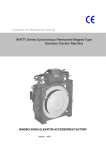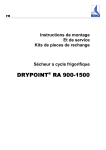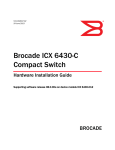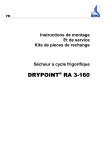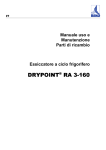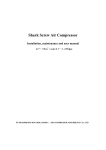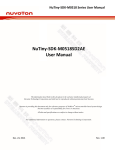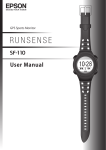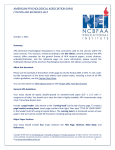Download User's Manual
Transcript
Compressor Ningbo Xinda “S” Series Fixed Oil Spray Screw Compressor User’s Manual (Please read this manual thoroughly before use) NO.CN03SF Ningbo Xinda Table of Contents Preface… … … … … … … … … … … … … … … … … … … … … … … … … … … … … … … … … .… … 1 Chapter I Safety Precautions… … … … … … … … … … … … … … … … … … … … … … … .… ..2 Chapter II Installation Standards and Requirements… … … … … … … … … … … … … … … … 3 Chapter III Performance Parameters and Apparent Dimension of the Unit… … … … … … … ..6 Chapter IV Flow Process and Functions of the Compressor System...… … … … … … … … .… 8 Chapter V Electrical Control System..… … … … … … … … … … … … … … … … … … … … … 12 Chapter VI Operating Guide… … … … … … … … … … … … … … … … … … … … … … … … … .14 Chapter VII Maintenance… … … … … … … … … … … … … … … … … … … … … … … … … … … 16 Chapter VIIII Common Faults and Solutions… … … … … … … … … … … … … … … … … … … … 20 Enclosure: Warranty Card Enclosure: Memorandum Ningbo Xinda Preface Dear User, thank you very much for buying Ningbo Xinda “S” series products. We sincerely hope that you can feedback the information related with the product use to us so that we can provide more satisfactory services to our customers, as your expectation is our objective. This Manual provides an overall description about the correct methods and related precautions for the installation, operation and maintenance of Xinda screw compressors. In order to ensure that the compressor can operate economically and optimally with high safety, and increase its service life to the greatest extent, please read this manual carefully before use, to understand its basic construction, operating principles and standard operation and strictly observe relevant safety regulations. The operators should have this manual in hand. This series of products is designed according to the compressor standards JB/T6430 and have been tested strictly in its operation before the products leave the factory. Its performance test is carried out according to the national standards GB/T3853-1998 eqv ISO1217 1996, and its performance meets the optimal design requirements. The maintenance must be carried out by qualified personnel. Please contact us for further information (See the back cover). Note: This manual is applicable to following types: SF45, SF55, SF75, SF90, SF110 and SF132 series of products As the product is improved and updated, our company has right to modify this manual without notice. Important: the consequences resulted from violation of the instructions in this manual shall not be covered in the warranty services of our company. Copyright reserved. This manual must not be reprinted, or otherwise related legal responsibility should be affixed for. NO. CN03SF China Ningbo Xinda Screw Compressor Co., Ltd. Ningbo Xinda Chapter I Safety Precautions The air, oil and electricity inside the compressor can cause dangers. Please enhance safety consciousness, ensure safe operation and carry out inspection and maintenance correctly, in order to prevent dangers and faults. The products of this series are not designed to operate under water and in other enclosed rooms. Therefore, their use in these applications is strictly prohibited, in order to avoid serious dangers or accidents. If the product is used as the equipment for producing the air for human breath, it is necessary to fully purify the air according to local standards and regulations in order to meet the breathing standard and prevent pollution to the atmosphere and the air for human breath. Main Safety Precautions: 1. Do not start any inspection or maintenance work until the power supply is turned off and the air in the whole compressor system has been discharged completely (internal pressure in the unit is equal to the atmospheric pressure). 2. Before start up, by turning on the power supply for a short moment (about one second), check whether the compressor rotates in correct direction. Or otherwise the screw assembly of the compressor will be damaged within a few seconds. 3. Ensure that clean gas is absorbed into the machine during its operation, and there is no flammable, explosive or toxic gas. 4. Before the unit operation, it is necessary to ensure that all the connectors and accessories are tightened firmly. 5. Do not loosen or remove any pipe fittings, connectors and components during operation, in order to prevent serious damage or injury. 6. Air switch, fuser or other safety devices must be installed on the power supply circuit of the compressor, in order to ensure reliability of electrical equipment. Ensure correct earthing according to safety regulations of relevant authority. 7. The compressor should not operate at the discharge pressure greater than the value indicated on its nameplate. Or otherwise the motor will be overloaded and the unit will stop operation. 8. Safety valve is installed on the air-oil separator. When the gas pressure inside the system exceeds the set pressure, the safety valve will act. In this case, it is necessary to find the causes and troubleshoot. 9. Do not use corrosive chemical solvents to clean the compressor and auxiliary equipment. 10. The compressor cannot be used directly for producing the air for human breath. If the compressed air must meet breathing standard, corresponding treatment should be conducted after purification. Safety measures should be taken for other gas equipment, especially in the applications that are not mentioned in this manual. 11. During the operation of the unit, the door of the unit casing body should be closed, and this door can be open for a while only if the unit is checked. However, please pay attention to the harms caused to human body by moving parts and high-temperature parts, and wear protective ear cover correctly. Do not leave any objects on or inside the unit. 12. The pressure vessel cannot be repaired or re-welded, and it is prohibited to check the internal parts of the compressor or pressure vessel using open flame light source. 13. Ensure there is complete sound insulation material on the compressor. Please contact our company if the material is damaged. Caution: Before starting up the compressor, related operators must read and understand this manual, and should contact the service personnel of Xinda Company if they have any questions. We will provide best services in the possible shortest time. We do not take any responsibilities for the damages and injuries caused due to neglecting safety precautions or non-safe operations, even if these precautions or non-safe operation is not mentioned in this manual. Chapter II Installation Standards and Requirements 1. Requirements for Arrangement in Installation Place (1) Compressor house should be as near to load center as possible, in order to reduce pipe length, pressure loss and power consumption and ensure air supply pressure. (2) Scientific supply of electrical power, water supply and ventilation should be taken into account in the house planning. (3) To suit to the development in the future, space should be reserved on the general drawing for expansion. (4) Air compressor suctions air directly from atmosphere. In order to reduce the possible wear, corrosion and explosion of compressor unit, there must be specified distance between the compressor house and the place where there is explosive, corrosive, toxic gas or dust or other harmful substances, and the compressor house should be located on lower side of annual wind directions occurring at least frequency in aforesaid places, so that the effect of harmful substances on the house is minimized. (5) Since the compressor gives out a plenty of heat, especially in summer when high temperature exists inside the unit, the compressor house should be oriented to the direction in which the machine is well-ventilated and the sunshine time can be reduced. (6) Though the compressor is provided with casing, raining on it is strictly prohibited. Hence compressor should be not mounted outdoors. (7) Compressor house should be a separate building. 2. Precautions during Handling (1) In order to ensure safe handling, please pay attention to the total weight of the compressor unit. (2) When the unit is handled on a fork, soft gaskets should be used for protecting the unit from surface damage. The fork teeth should be inserted completely into the compressor base. (3) When the unit is handled with the help of a crane, balancing should be ensured. The steel wire rope should be fixed on correct positions and slings should be prepared to prevent the rope from pressurizing on the compressor casing, or otherwise the casing will get damaged. (4) Transportation bracket should be installed and the fixtures should be tightened and locked first when the compressor unit is transported and handled, in order to prevent possible damages to the compressor, as shown in the figure. After compressor unit is mounted in position, it is necessary to remove the bracket and fixtures shown in the figure before the compressor is put into operation! Bracket for transportation and handling Fixtures for locking the compressor during transportation and handling 3. Requirements for Compressor House Installation (1) Sufficient space should be reserved in the installation place for subsequent maintenance and repair work to be done. The floor had better be finished cement floor and its unevenness should not be greater than 0.5/1000 (mm), and the floor should be enough hard and firm to support the weight of the compressor. (2) The compressor should be placed on horizontal floor, and good joint must be ensured between the casing bottom and floor surface, in order to prevent vibrations and noises. (3) If possible, sound absorbing board can be fitted on the walls of compressor house in order to further reduce the noises. However, the materials with hard surface (such as ceramic tiles) should not be fitted on the walls. (4) The recommended minimum spacing from compressor installation position to the front side, rear side, left side, right side and the top should be greater than 1m. (5) Since air-cooled compressor is apparently affected by the ambient temperature, the compressor house should be well-ventilated and dry. An exhaust fan should be mounted in it and sufficient incoming air volume should be provided, in order to ensure that air flowrate is lower than 4.5m/s at air inlet window and ambient temperature should be within –5oC~40oC. The following figure shows compressor ventilation designs: (6) There is a small quantity of dust and clean air as well as no harmful gases, sulfurous acids and other corrosive medium in the compressor house. 4. Pipeline Installation Requirements (1) The air outlet of the compressor unit is provided with threaded connector for connection with your air supply pipeline. Please refer to Chapter III “Performance Parameters and Apparent Dimension of the Unit” for installation dimensions. (2) The branches must be connected from the top of main pipeline in order to avoid condensation water in the pipes from flowing down into the compressor. (3) The pipeline should be as short and straight as possible when it is laid around the whole production building, in order to minimize the number of bends and valves and the pressure loss. The post treatment system should be provided with maintenance by-pass if possible. 5. Connection and Arrangement of Air Pipeline (1) Compressed air pipes are connected by welding, but the pipe and equipment or valve should be connected using corresponding flange or screwed connections. The pipes that are often removed should be connected using screwed connections if the pipe diameter is less than or equal to DN 25, and connected using flanges if the pipe diameter is greater than DN 25. (2) For the pipeline that delivers compressed air that is not dried and purified, the pipeline generally should be laid at a slope of more than 2/1000, and a blow-off valve (screwed plug) should be mounted on its low end. The pipeline should be laid as short and straight as possible and least bends and valves should be used, in order to drain the wastewater in the pipes better. (3) The top of underground pipeline should be embedded in 0.7m at least under the ground, but this restriction is not applicable to the pipeline that delivers dry and purified compressed air. (4) After completion of system installation, air pressure test and air-tightness test should be carried out, and hydrostatic test should not be carried out. The test pressure is 1.05~1.5 times the pressure of the same gas, and if no leakage is detected, the pipeline is acceptable. (5) Air receiver tank is pressure vessel, and all the necessary safety valve, pressure gauge, blow-off valve and other safety accessories should be mounted correctly and be reported to local labor authority for records. Annual routine inspection must be carried out every year. 6. Selection of Pipe Size While gas flows inside the pipeline, it has friction resistance in straight pipes and local resistance in the valves, tees, bends and reduced pipes, which will cause gas pressure loss. Generally, pressure drop in a pipe length can be obtained from the data in following table: Air Flow --- Pipe Pressure Drop kg/cm2 ---(100m) Air flow 3 Pipe Diameter (inch) m /min 1 1/2 2 6.5 2.50 0.709 7.0 2.90 7.5 2 1/2 3 3 1/2 4 5 0.187 0.0744 0.0346 0.815 0.217 0.0863 0.0401 3.33 0.940 0.249 0.0990 0.0460 8.0 3.79 1.0 0.283 0.113 0.0524 0.0247 8.5 4.28 1.21 0.319 0.127 0.0590 0.0309 9.0 4.80 1.35 0.359 0.143 0.0662 0.0347 9.5 5.35 1.51 0.399 0.159 0.0738 0.0386 10 5.93 1.67 0.442 0.176 0.0818 0.0428 12 8.53 2.40 0.637 0.254 0.118 0.0616 0.0196 14 11.6 3.27 0.866 0.345 0.160 0.0839 0.0260 Air flow Pipe Diameter (inch) 3 m /min 2 2 1/2 3 3 1/2 4 5 15 3.76 0.995 0.396 0.184 0.0963 0.0306 16 4.28 1.13 0.450 0.209 0.110 0.0348 18 5.41 1.14 0.570 0.265 0.139 0.0441 0.0177 20 6.68 1.77 0.704 0.327 0.171 0.0544 0.0219 22 8.08 2.14 0.851 0.396 0.209 0.0659 0.0265 24 9.62 2.55 1.01 0.471 0.246 0.0784 0.0315 28 11.3 2.99 1.19 0.553 0.289 0.0920 0.0370 30 15.0 3.98 1.58 0.736 0.385 0.122 0.0429 35 20.4 5.41 2.16 1.00 0.525 0.167 0.0670 7.08 2.82 1.31 0.618 0.218 0.0876 40 6 Notes: 1. Actual pressure drop in a straight pipe section = gauge value pipe length (100 compression ratio). (Compression ratio = gauge pressure +1); 2. The total pressure drop in the pipeline should include the local pressure losses caused in the bends, reduced pipes, tees and valves, which can be found in related manuals. 3. After referred to the tables, it is necessary to check whether the pressure loss of compressed air supplied to the user end is within the permissible range. The experience shows that total pressure loss should not exceed 0.4kg/cm2 in 100m pipeline length. If it exceeds this value, the pipe diameter must be increased. Chapter III Performance Parameters and Apparent Dimension of the Unit S Type compressor unit is motor-driven immovable oil-spray screw compressor and SF Type unit is air-cooled compressor. The performance parameters and apparent dimensions of SF45~SF132 are shown in the table below: Type Air flow /Pressure m3/min/Mpa A B C D SF45 SF55 SF75 SF90 SF110 SF132 7.5/0.7 6.6/1.0 5.2/1.3 7.2/0.8 10.2/0.7 8.2/1.0 7.2/1.3 9.5/0.8 13.5/0/7 11.5/1.0 9.5/1.3 12.4/0.8 16.5/0.7 13.7/1.0 11.5/1.3 15.5/0.8 20.0/0/7 17.0/1.0 14.0/1.3 18.5/0.8 23.5/0/7 20.5/1.0 16.6/1.3 22.5/0/8 Cooling method Drive method Temperature Form Power (Kw) Rev(r/min) Motor Voltage /Frequency (V/Hz) Insulation Class Oil fill quantity (L) Weight (kg)_ Wind chilling Belt drive Air temperature: ambient temperature is below +15 Required ambient temperature -5 to +40 Three-phase squirrel-cage asynchronous motor 45 55 75 90 110 1480 2970 1480 132 3-AC380±5%/50 F 50 1950 50 1990 55 2100 75 2200 85 2500 85 2600 1. Main power lead-in port a. Heat dissipation and air discharge e. Air supply port 2. Compressed air inlet b. Air discharge f. Power lead-in port 3. RP2 compressed air inlet c. Air supply g. Cooling air inlet 4. Heat dissipation and discharge outlet d. Hot air outlet Chapter IV Flow Process and Functions of the Compressor System 1. System Flow Process “S” series compressor system has flow process shown in following diagram. It consists of air system, lubricant system and cooling system. Its drive section is classified into belt drive and coupling drive. All the compressors of this series have gear drives. 1. 2. 3. 4. 5. 6. 7. 8. Gas pipeline Oil and air mixing pipeline Oil pipeline Control pipeline Incoming air Air filter Air intake valve Gearbox 9. 10. 11. 12. 13. 14. 15. 16. Coupling Motor Compressor Control valve Solenoid valve Pressure maintaining valve Safety valve Filtering element 17. 18. 19. 20. 21. 22. 23. 24. Air-oil separator Filling hole Blow-off valve Temperature control valve Engine oil filter Oil cooler After cooler Air supply opening (1) Flow process of air system After dust in the air is removed in the air filter, the air flows through the intake control valve and into the compressor where it is compressed. The compressed oil-air mixing gas enters the air-oil separator. After the air is separated from oil in the separator, the air flows through the min. pressure valve and after cooler, and finally is discharged from air supply valve. The separated oil is left in the tank of the air-oil separator and enters lubricant circulation system. 1.1 Air filter The air filter is dry paper-medium filter. Its function is to purify the suctioned air, guarantee the cleanness inside the system and increase the service life of bearing of the compressor, air-oil separator, filtering element and oil filter. Maintenance frequency should be increased under severe conditions. As shown in the diagram. Air Filter Air Filter Element 1.2 Intake control valve The intake control valve functions together with solenoid valve and pressure switch and is used to control supplied air volume of compressor. When the compressor unit is started up, this valve closes and compressor is started up at low loads. When the compressor runs at full load, this valve is full open. When load is adjusted, this valve closes, and reduces the pressure in air-oil separator to 0.3~0.45 MPa, so that the system runs at no load and oil supply pressure can be guaranteed in compressor. It has non-return function, and can prevent reverse flow of the air in air-oil separator, which will cause inverse rotation of the rotor and oil spraying from the air inlet, as shown in the diagram: 1.3 Temperature switch The temperature switch also has the function of indicating and controlling the air discharge temperature. Oil loss, insufficient oil volume and bad cooling effect of the system will possibly result in too high discharge temperature. When this temperature reaches the stop temperature setting of the temperature switch, the compressor will stop operation. The stop temperature setting of the temperature switch is 105oC. 1.4 Safety valve When the load adjustment system malfunctions, and the pressure in air-oil separator is more than 1.1 times the rated discharge pressure, the safety valve will automatically trip and releases the pressure, in order to guarantee safety. When the air pressure is reduced to a certain valve, the safety valve will automatically close. n The safety valve has been adjusted and set correctly before leaving the factory. Please do not make any adjustment! 1.5 Min. pressure valve Min. pressure valve is located above the air-oil separator, and its opening pressure is 0.35~0.4MPa. Its main function is as follows: a. Rapidly establish the air pressure when the compressor is just started up, provide the pressure needed for lubrication for compressor, and enable the intake control valve to open in specified time. b. Control the air flow rate in filtering element of the air-oil separator, ensure the air-oil separation effect and prevent the damages caused to the filtering element due to too great pressure difference. c. It has non-return function and can prevent the pressure gas after min. pressure valve from flowing back into the air-oil separator when the load is adjusted and the compressor stops. 1.6 Pressure Control The pressure sensor installed on the after cooler transmits obtained signal to a microcomputer-based controller for the adjustment of compressor load. When gas supply pressure reaches the upper limit of preset pressure, the microcomputer-based controller sends a signal, which causes gas inlet control valve to be closed and compressor to run at no load. When gas supply pressure is reduced to the lower limit of preset pressure, the microcomputer-based controller sends a signal to a solenoid valve, which causes all the gas inlet control valves to be opened and compressor to run at full load. SP2 shown in the figure is a pressure switch and can convert the pressure signal into electric signal. This switch is used for overpressure protection control of the compressor. When load adjusting system malfunctions and discharge pressure of the compressor reaches the setting of SP2 pressure switch, SP2 operates and stops the compressor, and then sends overpressure alarm signal. 1.7 After cooler The after cooler is an efficient plate-wing structure and is integrated with the oil cooler. It is used for cooling the high-temperature compressed gas discharged from the compressor in order to control the temperature of supplied air to +15oC or less. 2. Flow Process of Lubricating System The lubricant system consists of air-oil separator, temperature control valve, oil cooler and oil filter (refer to the System Flow Chart). The lubricating oil in the air-oil separator enters the oil pipeline under the action of gas pressure, flows through temperature control valve and oil cooler, then is filtered in the oil filter. After than, the oil flow is divided into two branches. One branch is that oil is sprayed into the rotor of compressor from lower part, and the other branch is that oil is led to the front and rear bearing pedestals for bearing lubrication. Then the oil merges in the rotor of compressor, and is mixed with the gas and then is discharged into air-oil separator. After the oil is separated from the air in the separator, the oil stays in the separator and enters next cycle. 2.1 Oil cooler Oil cooler is an efficient plate-wing structure and is integrated with the after cooler. It is used for cooling of lubricating oil in order to ensure normal operation of the system. 2.2 Oil filter Oil filter is a screwed filter with paper media and its filter precision is 10µm. It can remove foreign matters in the oil, for example metal particles, deteriorated oil, etc. in order to guarantee the normal operation of the compressor. In the oil filter, there is a safety valve. When the filter element is blocked, or its service life period expires, or the pressure difference between front side and rear side of the filter element reaches 0.15~0.2MPa, the safety valve will open, oil is bypassed and is injected into the compressor without being filtered, which thus avoids the danger of oil loss in the compressor. However, after bypassing, a large quantity of dirt substances will be brought into the compressor, and if they are not treated in time, they will accelerate the bearing wearing and substantially reduce service life of the machine. Therefore the oil filter must be maintained and replaced in time!! 2.3 Air-oil separator The air-oil separator has one filter element in it, and the main function of this filtering element is to separate the mixture of oil and air discharged from the compressor. After this mixture enters the separator, firstly rough separation is carried out in order to remove most of the oil from the air. Then fine separation is carried out, in order to reduce oil content of the air to 1~3PPM or less. Besides, the air-oil separator can store lubricating oil and some pressure air. Caution: the filtering element in the air-oil separator is consumable goods and should be replaced in time! 2.4 Temperature control valve The function of temperature control valve is to automatically adjust the temperature of lubricating oil. When the temperature of lubricating oil is below 55oC, all the bypass ports of this valve open and oil does not pass through the cooler for cooling and is directly injected into compressor. When the temperature of lubricating oil rises, the bypass ports of this valve close gradually, and when the temperature of lubricating oil reaches 75oC, all the bypass ports of this valve close and all the oil go through the oil cooler and is injected into compressor after cooling. Therefore, on one hand, the valve keeps the air discharge temperature above the pressurized dew point in order to prevent liberation of water in the air and entering the lubricating oil. On the other hand, this valve ensures to rapidly supply lubricating oil to the compressor for lubricating it when it is started up at a low temperature. 3. Flow Diagram of Cooling System This series screw compressor is air-cooled compressor and is cooled using fans. The cooling system mainly consists of cooling fan, oil cooler and after cooler. The cooling air is suctioned by the fan, and blows towards the oil cooler and after cooler, and meanwhile it cools compressed air and lubricating oil. Pay attention to maintenance of coolers! Chapter V. Electrical Control System 1. Function of Control System Refer to “User’s Manual for Liquid Crystal Display Control System of Screw Compressor”. When the compressor must be stopped under normal conditions, please press “OFF” key on the instrument panel. Then the unit will run for some time at no load, and the motor does not stop until the pressure in the oil-gas separator is decreased to the specified value. The compressor unit will automatically stop if the compressor has abnormal conditions (for example overpressure, overtemperature, etc). There is a mushroom emergent stop button on the operation panel. This button should not be pressed unless there happen abnormal conditions on the unit. Or otherwise, oil will be possibly injected out of the gas inlet of the compressor. When the unit is restarted after the button is pressed and the cause is found and eliminated, this button should be pulled out in order to unchain the unit. Then press “ON” key and 10 sec later press “OFF” key. Repeat the key pressing operations twice in order to ensure that all residual oil flows back to the compressor, so that the unit can operate in good state. 2. Requirements for Power Supply and External Connection (1) Main power supply of this compressor is AC three-phase 380V/50Hz. Please confirm that the power supply is correct. (2) Voltage drop cannot exceed 5% of rated voltage, voltage difference between different phases should be within 3% and phase sequence protection wire should be fitted. (3) The power supply of compressor must be provided with disconnecting switch to prevent operation in case of phase loss caused due to shortcircuiting. (4) Check the fuser of secondary circuit, and select proper safety switch without fuser according to the power of the compressor. (5) The following table gives the requirements for user’s power supply and recommended lead-in size for the screw compressor made by our company: Recommended Cable Size (mm2) 50 or 2 25 50 or 2 25 70 or 2 35 70 or 2 35 Compressor Type Voltage (V) Frequency (Hz) Max. Current (A) SF45 series SF55 series SF75 series SF90 series 380 380 380 380 50 50 50 50 115 135 170 225 SF110 series 380 50 265 95 or 2 50 SF132 series 380 50 295 95 or 2 50 (6) It is preferable to use a separate electrical power system for the compressor, in order to avoid its parallel connection with other different power consumption systems. Especially when the compressor has high power, too high voltage drop or unbalanced three-phase current will possibly cause compressor overload and thus make the protection device to trip. (7) It is necessary to ensure correct earthing to prevent dangerous leaking current. Never connect to the air delivery pipeline or cooling water pipeline. Please observe local regulations if these regulations are stricter than above-mentioned requirements. 3. Unit-related Identification Labels A. Never touch or repair the cooling fan during the operation of compressor unit, in order to avoid personal injury. B. Never touch or stand near the drive parts during the operation of compressor unit, in order to avoid personal injury. C. Never touch high-temperature parts during the operation of compressor unit or before it cools down, in order to prevent scalding. D. Warning labels E. The moving parts of the unit are moving in the indicated direction. F. Recommended torque for tightening the bolts for user power supply’s lead in. Chapter VI Operating Instructions 1. Check Prior to Initial Start-up (1) Check the quantity of lubricating oil in the air-oil separator and the oil quantity is optimal when the oil level indicated on oil dipstick is between upper limit and lower limit. (2) The electrical connections and earth connection have been completed, and comply with safety standards. (3) Air supply pipeline is unblocked, and all the screwed plugs and connections are tightened firmly. (4) Check if power supply and voltage of the motor and indications on the instrument panel are correct and ensure the compressor will start up at no load. (5) If the compressor commissioning is carried out after a long time since it is delivered, fill about 0.5-liter lubricating oil into the air inlet and manually rotate the compressor by several revolutions or inch it several times, in order to prevent compressor burning due to insufficient oil at startup. Please take special care not to let foreign matters fall into the machine, which will cause damage to the compressor. (6) Operate the valve according to process pipeline operation requirements and the air discharge valve of the compressor should be in open position. (7) When it is ready for startup, check whether the operators are in safety position. (8) Close the manual blow-off valve 2. Initial Startup (1) First switch on the power supply, and observe that phase sequence indication on the instrument panel is normal. Then press “ON” key to inch the compressor. For the sake of safety, please check if the unit rotates in right direction as shown by the arrow. If it rotates in right direction, a person can clearly feel that there is suction force at air inlet of air filter (please use one finger to try it). Or otherwise the unit rotates in wrong direction. Immediately switch off the power supply, and change any two of the three power lines. Reverse rotation of the motor is strictly prohibited. (2) Press “ON” key to start the operation, and the compressor will run in the preset mode. At this time, check if the instruments and indicators are normal and pressure and temperature is normal, and check if are given out and there is abnormal sound and oil leakage. If there is, immediately stop the compressor and check it. (3) Stop the compressor and press “OFF” key, and after delay time and unloading, the unit will completely stop. Not immediately stopping is normal. Caution: only when there is special and abnormal condition, can the emergency stop button be pressed manually to stop the unit emergently. After faults are eliminated, if it is necessary to re-start the unit, the unit should not be started up until after 60 seconds the system pressure is unloaded completely. Caution: the parameters of the compressor unit are set in the factory before it is delivered. Please contact our company if the parameter setting must be changed under special conditions, or otherwise the user should take responsibility for possible serious consequences. 4. Normal Operations (1) Preparations before startup: check the oil level in the air-oil separator and slightly open the release valve under the air-oil separator, in order to drain the possible condensate water accumulating in it. Make sure that no condensate water exists in the separator and then tighten this valve, and open the valve at air supply opening of the compressor. (2) Start up: Switch on the power supply, and press the “ON” key on the instrument panel, and the compressor starts operation. If air discharge pressure must be adjusted, please gradually adjust the valve at air supply opening of the compressor to smaller opening. (3) Stop operation: Press the “OFF” key on instrument panel, and the compressor starts to operate at unloading for some time and then come to a stop. If the compressor is not used, switch off the power supply and close the valve at air supply opening of the compressor. [Cautions] Warning: The compressor will stop automatically if it runs at no load for a long time. When this happens, never start any check or repair work, as the compressor will resume operation at any time. The compressor unit with separate fan, can automatically control the operation and stop of its fan, so please never touch the fan, in order to avoid personal injury. The power supply must be disconnected before checks! Warning: after power supply is switched off, the compressor will suddenly stop operation. In this case, remember to disconnect the power supply of compressor, so that the electrical control part will not be burnt in the event of sudden power-on. Besides, there may be other hidden risks. Chapter VII Maintenance 1. Maintenance Interval and Items of Screw Compressor Maintenance Operating Maintenance Items Interval Hours (h) Before startup, drain the condensate completely and check whether the oil level, indicators on the operation panel or the indications on Daily 8 the text display are normal, and the readings of the timer is effective, and also check the differential pressure gauge and temperature. Check the leakage and clean the unit. Check if there is any Weekly 80 abnormal noise. Carry out first oil change after new compressor runs in, replace the Every three oil filter, and carry out the maintenance according to the 500 months indications of the maintenance indicator on the air filter depending on the operating conditions Manually check the safety valve, clean the cooler, replace the element of air filter, replace the oil filter, change the oil, check the 2000 thermometer, refill lubricants into the motor, and test electrical control system. Replace the element of oil-gas separator, check belt tension according to the type of the belt drive (replace the belts if the Every year 3000 tension is beyond adjustable range), and check the tightening of moving parts. Check if the temperature control valve works normally. Check all 4000 the connections of oil and air pipelines. Check the adjustment of pressure switch. Check if emptying operation is good. Note: Above-mentioned maintenance intervals depend on actual operating conditions and operational performance. 2. Specification and Application of Lubricating Oil Please refer to the motor operating instructions for the refilling and change periods of lubricating greases of motor. In general, the motor bearing must be filled with grease every 2000h operation of the motor. Greasing points are marked on the motor, and users should refill designated grease correctly as required in the operating instructions. Use of the greases of different brands will reduce the service life of the motor. Note: make sure that no contaminants are mixed with the grease during grease refilling. Grease of proper quantity should be added. Refilling excessive grease will cause damages to the bearing. Lubricating oil (grease) has decisive influence on the performance of the complete oil-sprayed screw compressor unit. If improper or incorrect oil (grease) is used, serious damage will be caused to the compressor. Therefore, following regulations must be observed: (1) Recommended oil (grease) brand used for screw compressor: Item Viscosity at Viscosity at Flash Point Pour Point Viscosity Type 40oC 100oC o o ( C) ( C) Index Brand (mm2/s) (mm2/s) SHELL CORENA46 46 6 242 -35 144 (2) Precautions for Use of Lubricating Oil 2.1 The oil product should comply with related requirements. Never use the lubricating oils (greases) of different brands and types together. It is strictly prohibited to use counterfeited oils or reclaimed oils. The brand of lubricating oil (grease) to be filled is specified in the factory’s document supplied with each compressor. 2.2 The oil (grease) has following performance requirements: excellent anti-oxidizing, anti-foaming, anti-corrosion and abrasion resistance performance, strong water diversion, suitable viscosity, high flash point and low pour point. 2.3 Do not use the lubricating oil (grease) that is beyond its service life. Or otherwise its quality will deteriorated and its flash point will be reduced accordingly, possibly causing oil self-ignition and burnt unit. 2.4 Observe the oil change period. In order to determine oil change period according to the actual conditions, it is recommended that the oil should be changed every 3~6 months within first two years, and oil sample should be obtained for analysis periodically, and our company will provide necessary technical instructions in order to determine actual oil change period and avoid waste of oil product. (Caution: oil should be changed after initial running-in of 700~800h). 2.5 After the compressor operates for two years, it had better be “washed” with the lubricating oil. The method is to change the oil twice successively: a second oil change is carried out after the compressor operates for six hours after first oil change. 2.6 The oil filter must be replaced whenever oil change occurs. (3) Factors affecting oil change time 3.1 Poor ventilation, and excessive high ambient temperature; 3.2 High humidity or in rainy season 3.3 In dusty environment 3.4 Lubricating oils of different brands are used together. (4). Steps for Oil Change 4.1 Run the compressor and after oil temperature rises, press “OFF” key to stop the compressor. 4.2 After discharge pressure is reduced to zero, close the shutoff valve at air supply opening of the compressor, slowly open the release valve under air-oil separator to drain all the waste oil in it. Inch the compressor in its rotation direction, and fill some fresh oil through the oil filler in order to completely clean it. 4.3 Drain all the lubricating oil in oil cooler, oil pipeline and other systems. 4.4 Tighten release valve under the air-oil separator, fill fresh oil through the oil filler. Since there is not oil in oil cooler and oil pipeline, more fresh oil should be filled. 4.5 Start up the compressor, check oil level. If oil level is not enough, refill lubricating oil of proper quantity after the compressor is stopped. 3. Adjustment of Control Devices (1) Adjustment of safety valve Generally, discharge pressure of safety valve is set to 1.1 times rated discharge pressure at the factory, so adjustment is unnecessary. If it is necessary to adjust the discharge pressure of safety valve due to other reasons, unscrew the locking nut on the top of safety valve, rotate the screw in clockwise direction to increase the discharge pressure; or rotate the screw in counterclockwise direction to decrease the discharge pressure. After adjustment, do not forget to tighten the locking nut and lock it. (2) Adjustment of pressure switch 1. Pressure difference adjusting screw 2. Pressure difference adjustment 3. Pressure adjusting screw 4. Pressure adjustment a. Turn the pressure difference adjusting screw in counterclockwise direction, and the preset pressure can be increased. b. Turn the pressure difference adjusting screw in counterclockwise direction, and the preset pressure difference can be increased, for example, if operating pressure is 0.7MPa and pressure difference is 0.2MPa, the pressure adjusting range is 0.7MPa~0.5MPa for full load/no load of compressor. c. The setting of pressure switch is completed at the factory. Do not adjust this pressure setting without authorization. The pressure difference can be adjusted according to actual use. 4. Maintenance of Air-oil Separator (1). Replacement of filtering element of air-oil separator When the lubricating oil quantity consumed by the compressor is substantially increased, check whether oil filter, oil pipeline and oil return pipe are blocked and clean them if necessary. If after that, a large quantity of lubricating oil is consumed, generally the air-oil separator has been deteriorated and must be replaced immediately. When the pressure difference between both ends of the air-oil separator filtering element is equal to 0.1MPa, it should be replaced. When the pressure difference is zero, there is a fault with the element or the air stream has been shortcircuited, and in this case the filter element also should be replaced. Following steps should be executed for the replacement: a. Confirm there is no pressure in the system after the unit is stopped, and then close the air outlet. Dismantle the pipeline of the air-oil separator, and also remove the pipeline from min. pressure valve to after cooler. b. Unscrew the fixing bolt of top flange gland of the air-oil separator, remove the flange gland, and take out filtering element of the air-oil separator. c. Install a new filtering element in the reverse order of removal steps (2) Replacement of oil filter Oil filter should be replaced when it needs maintenance. If it is not replaced in time, the air discharge temperature will possibly get very high and the unit is forced to stop. The more important thing is that serious bearing wearing of the compressor will be caused, so that the service life of bearing of compressor will be reduced greatly. To install a new oil filter, engine oil should be coated on the washer. After the filter is screwed in position, tighten it by 3/4 turn. When the oil filter is put into operation after replacement, check whether there is oil leakage. The replacement of oil filter is shown in the figure. (3) Cleaning of air filter Dust and other suspension particles in air will deposit in the element of air filter and cause blocking of the filter after it operates for some time. In this case, the spring in the filtering element maintenance indicator located under the air filter will be compressed slowly near to the red alarming mark, and the element must be replaced (after about 1000 operating hours). Under dusty ambient conditions, the element of air filter should be replaced more frequently. The filtering element should be cleaned and maintained frequently during normal operation. Stop the machine before removing the filtering element. It is recommended that a new filtering element or cleaned filtering element should be re-installed in position and then push the yellow button to reset the maintenance indicator, in order to shorten the downtime, as shown in the figure. To clean the filter element, lightly tap its two end faces to remove most of the dusts. Then blow compressed air of about 0.5MPa from interior to exterior. Position the spray nozzle about 25mm away from the fold paper. If there is much grease on filter paper, this paper should not be re-used. When the filter element is damaged (even if there is a tiny hole on it), it should not be re-used, and must be replaced immediately. (4) Cleaning of coolers After the compressor unit comes to stop, turn off air supply valve and power supply and purge it in reverse direction using compressed air. If serious blocking exists, and purging is impossible, immediate cleaning is necessary. Do not remove the dust with metal products. If immediate cleaning is not conduced, the cooling efficiency will be reduced, and thus air discharge temperature of compressor will be high enough to stop the compressor. (5) Draining water If the air discharge temperature is lower than dew point in rainy season and when a smaller quantity of air is consumed, the compressed air will possibly produce segregate water in the separator. Before starting up the compressor, the water should be drained by unscrewing the drain plug screw (valve) at the bottom of air-oil separator, in order to drain the water in it until oil flows out. A blow-off valve is installed on the bottom of air receiver tank, and contaminant should be drained in time. 5. Maintenance of Screw Compressor Unit (1) Please take following actions when the compressor is not in use: a. The storage place should keep dry and well-ventilated and there is suitable temperature; b. The rotor position should be changed if the compressor is not in use for over three months, so that the bearing contact points are changed. (2) The pipelines and circuits should be in good order, clean and smooth, and a good insulation is ensured. (3) The safety devices (such as safety valve, locking devices and automatic control or protection devices) are kept in safety, and the anti-explosion, lightning-proof and earthing devices should comply with safety requirements. (4) The equipment and workplace should keep clean and be in good order, without oil stains. The nomenclature plates are complete and pipelines and circuits are connected correctly and firmly. Chapter VIII. Common Faults and Solutions Symptoms The compressor unit will not start up Possible Causes Fuse is burnt Phase loss (error) or startup button has poor contact Incorrect setting or faults of pressure switch Motor overload protection trips/is damaged AC contactor is faulty The compressor does not reset to original position after it stops due to faults There are faults with compressor Compressor not build pressure does up Non-load operation is impossible or during non-load operation working pressure is still maintained or safety valve acts Air discharge volume and pressure are lower than normal value There are air leaks at min. pressure valve or control pipeline Air intake valve is seized at closing position Solenoid valve malfunctions Air filter element is clogged seriously Pressure switch SP1 does not function Air intake valve acts poorly Solenoid valve (or blow valve) does not function Filter element of air-oil separator is clogged. Adjusting value of safety valve is changed or it is defective Air filter element or oil filter element is clogged. System leaks Air consumption exceeds air discharge volume of compressor Air intake valve acts poorly Solenoid valve malfunctions or leaks Too low oil level Too high ambient temperature Too high discharge temperature or super-temperature protection Surface of oil cooler is too dirty There are faults with the fan or fan motor Oil filter is clogged There are faults with temperature control valve There are faults with thermocouple or temperature indication and control meter There is not unloading process due to emergent stop Solutions Check and replace it Check and replace it Re-set the pressure switch or replace it. Check the motor/wait for the motor to cool down Check, eliminate the faults or replace it. Press emergency stop button and reset Check the compressor, which can be turned with hand Check and make adjustment Check and replace it Check solenoid valve/circuit and replace it if necessary Clean/replace the element Check and adjust it, and replace it if necessary Check and repair air intake control valve Check and repair or replace it. Replace Re-adjust or replace it. Clean/replace the element Check the system and eliminate leakage Check equipment connections. Check and repair intake control valve Repair or replace it. Refill oil Enhance ambient ventilation and reduce ambient temperature Clean it. Repair or replace the fan Replace it. Repair or replace temperature control valve Check and repair or replace it. Avoid emergent stop (treat it as indicated on Page 12) Oil overflows at air inlet when compressor stops operation Discharged air has a high oil content and compressor consumes much oil Frequent changeover between operation at full load and operation at no load Air intake control valve malfunctions Solenoid valve (or blow valve) does not function There are faults with min. pressure valve, which is not non-return Too high oil level Oil return pipe/nozzle is clogged Filter element of air-oil separator is damaged The spring of min. pressure valve comes loose There are leakages at oil pipeline/shaft seal of the unit There are faults with computerized controller Air piping leaks There is too low pressure difference at pressure switch SP1 There is bad sealing at min. pressure valve Air consumption is not steady Overload protection Compressor unit gives abnormal sounds Oil leakage Low voltage High discharge pressure There are faults with compressor Bearing on main motor is worn There are faults with thermal protector of main motor Bearing on main motor is worn Bearing on fan motor is worn Bearing of compressor is worn Fan interferes with wind guard Belt comes loose Oil seal on air inlet end becomes aging Main Bad sealing at air discharge end machine Bad sealing at oil spout of compressor Bad sealing at discharge pipe and Oil and air connection piping Loose connections Bad sealing between flange cover Air-oil and tube body plane separator “O” seal ring of oil level gauge gets aging There is leakage at sealing surface of air suction valve Other parts There is oil leakage at seal ring on oil filter Check and repair it. Check and repair or replace it. Check and repair or replace it. Drain extra oil to reduce oil level Remove and clean it. Replace the element. Adjust it or replace it with a new one Check leaking points and repair. Check if the input/output indicator works normally (as per electrical schematic diagram) Check and repair Re-adjust pressure difference of pressure switch Check and treat the sealing surface of this valve Increase the volume of air receiver tank Modify the circuit Re-adjust pressure control Check and repair compressor Check and replace it Check the thermistor of the motor Check and replace it Check and replace it Check and replace it Adjust the clearance Adjust it Replace Replace Replace the seal Replace Tighten the connector Replace asbestos gasket Replace it. Clean it and then coat a layer of adhesive on it. Re-install it in position Replace the seal ring or re-install it after cleaning Maintenance Card Compressor Type:___________ Date Remark Operating Hours Indicator Status Normal going-out Temp O C Preferable below 90oC Oil Level Between marks Machine Number: _____________________ O: Normal X: Abnormal Pressure Difference of Separator Safety Valve Current A Pull-ring test Oil and Air Leakage Automatic Drain Water Noise Drain Water in Separator Automatic Unloading Drain before startup Name of User: Stop Check Maintenance or Fault Solution Record Record of faults and replaced parts Maintenance Person Memorandum: ---------------------------------------------------------------------------------------------------------------------------------------------------------------------------------------------------------------------------------------------------------------------------------------------------------------------------------------------------------------------------------------------------------------------------------------------------------------------------------------------------------------------------------------------------------------------------------------------------------------------------------------------------------------------------------------------------------------------------------------------------------------------------------------------------------------------------------------------------------------------------------------------------------------------------------------------------------------------------------------------------------------------------------------------------------------------------------------------------------------------------------------------------------------------------------------------------------------------------------------------------------------------------------------------------------------------------------------------------------------------------------------------------------------------------------------------------------------------------------------------------------------------------------------------------------------------------------------------------------------------------------------------------------------------------------------------------------------------------------------------------------------------------------------------------------------------------------------------------------------------------------------------------------------------------------------------------------------------------------------------------------------------------------------------------------------------------------------------------------------------------------------------------------------------------------------------------------------------------------------------------------------------------------------------------------------------------------------------------------------------------------------------------------------------------------------------------------------------------------------------------------------------------------------------------------------------------------------------------------------------------------------------------------------------------------------------------------------------------------------------------------------------------------------------------------------------------------------------------------------------------------------------------------------------------------------------------------------------------------------------------------------------------------------------- Compression is a creation and is an art as well. We will devote ourselves to that and provide perfect power for modern industry. Customer’s expectation is Xinda’s objective. Our experience of many years prove that Focusing product seriation on the compressor types mostly needed by customers can allows more effective reduction in user’s investment and operating cost. Constantly increasing production efficiency is our first task During such seriation, we will meet competitor’s challenges with more professional technology and greater investment! . NINGBO XINDA SCREW COMPRESSOR CO., LTD ONE OF CHINA NINGBO XINDA GROUP CO., LTD. ADD: DONGWU, YINZHOU, NINGBO, ZHEJIANG, CHINA TEL: 0086-574-88336262 FAX:0086-574-88489056 POSTCODE: 315113 URL:http://www.xinda-group.com E-MAIL: [email protected]






























